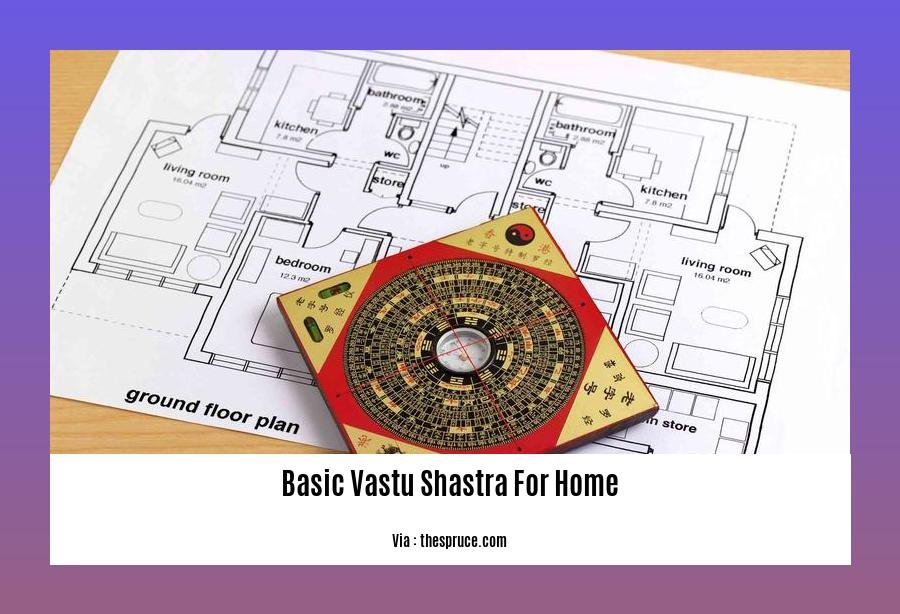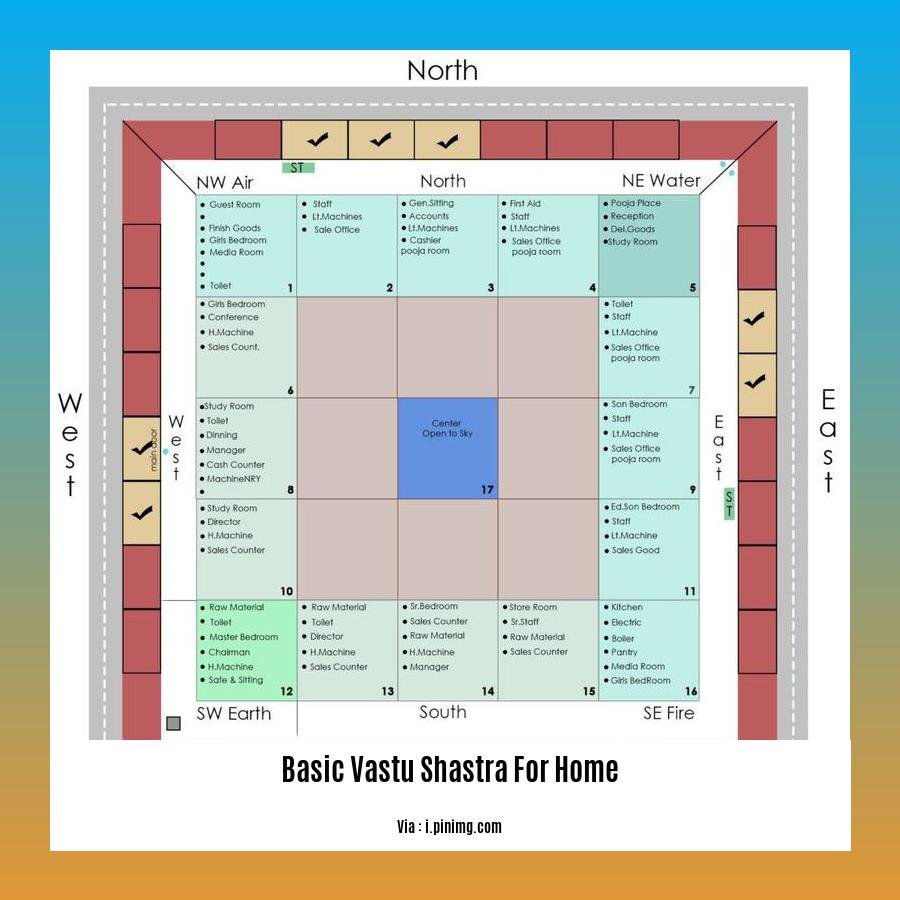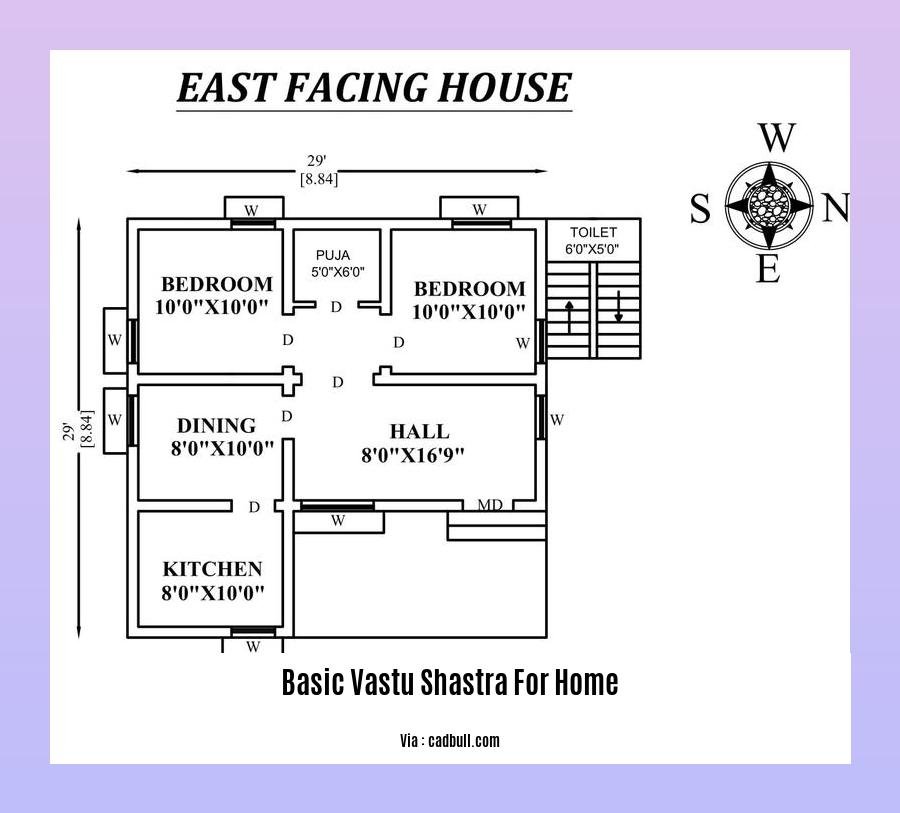Welcome to the realm of Vastu Shastra, an ancient Indian architectural science that harmonizes the energies of a home with its inhabitants to promote well-being, prosperity, and overall happiness. In this comprehensive guide, [- Basic Vastu Shastra for Home: A Guide to Creating Harmonious Living Spaces], we delve into the fundamental principles of Vastu and provide practical tips to transform your home into a sanctuary of positivity and balance.
Key Takeaways:
-
Prioritize square or rectangular room shapes.
-
Ensure rooms are well-lit, airy, and clean, extending to the corners.
-
Dedicate the center of the house as an empty space.
-
Place heavy furniture in the southwest direction.
-
Position water features, like fountains or aquariums, in the northeast.
-
Set the dining table in the east or southeast direction.
-
Avoid placing mirrors opposite each other or facing the main door.
Basic Vastu Shastra for Home

“Vastu Shastra” is an ancient Indian science of architecture that seeks to harmonize humans with their environment through design. It emphasizes the importance of designing structures that resonate with the natural world, promoting balance and well-being. Here are some fundamental principles of Basic Vastu Shastra for Home:
1. Orientation and Entrance
- Main Door:
- The main entrance should face north, east, or northeast, allowing positive energy to flow in.
- Avoid having south-facing front doors.
- Placement:
- Position the main entrance in the center or eastern side of the house.
- Entrance Design:
- Use wooden or metal doors, avoiding heavy materials like iron or steel.
2. Room Placement
- Living Room:
- Place the living room in the north, east, or northeast for peace and harmony.
- Position the main sofa facing the east or north.
- Bedrooms:
- Design the master bedroom in the southwest corner for stability and deep sleep.
- Kitchen:
- Position the kitchen in the southeast direction for good health and culinary success.
- Bathrooms:
- Place the bathroom in the northwest or southwest corner for proper drainage.
3. Water Elements
- Placement:
- Water elements like fountains, aquariums, or fish tanks should be placed in the northeast corner.
- Shape and Size:
- Use round or rectangular water features, avoiding sharp or irregular shapes.
- Size should be proportionate to the space.
4. Colors and Interior Design
- Colors:
- Choose light and soothing colors for the walls and interiors.
- Avoid dark or dull colors that can create negative energy.
- Materials:
- Opt for natural materials like wood, stone, and cotton for furniture and décor.
- Décor:
- Incorporate plants, artwork, and objects that bring joy and positive energy.
5. Energy Flow
- Airy and Bright Spaces:
- Ensure proper ventilation and natural light in all rooms.
- Keep windows and doors open to allow fresh air to circulate.
- Open Spaces:
- Design open and spacious living areas to promote energy flow.
- Clutter-Free:
- Keep the house clutter-free to prevent negative energy.
6. Balance and Proportion
- Symmetry:
- Design the house with symmetry in mind, creating a balanced and harmonious appearance.
- Room Sizes:
- Maintain proportional room sizes, avoiding overly large or small spaces.
By incorporating Basic Vastu Shastra principles into your home design, you can create a nurturing and harmonious living space that resonates with positive energy, promoting well-being and prosperity for all occupants.
-
Explore the remarkable Benefits of Homeopathy and discover how this holistic approach can contribute to your overall well-being. ../benefits-of-homeopathy
-
Unveil the remarkable Berberis aquifolium Homeopathic Medicine Uses and learn how this natural remedy can alleviate various health concerns. ../berberis-aquifolium-homeopathic-medicine-uses
-
Delve into the extensive Berberis aquifolium Homeopathic Uses and discover the comprehensive range of conditions it can address. ../berberis-aquifolium-homeopathic-uses
-
Explore the therapeutic properties of Berberis Vulgaris Q Homeopathic Medicine Uses and uncover its potential to alleviate a wide range of ailments. ../berberis-vulgaris-q-homeopathic-medicine-uses
Key Elements and Directions in Vastu Shastra

Vastu Shastra is a traditional Indian architectural system that promotes creating structures that resonate with the natural world, fostering balance and well-being. Understanding the Key Elements and Directions in Vastu Shastra is vital in designing harmonious living spaces.
Vastu emphasizes that the dwelling’s orientation and entrance are crucial. Ideally, the main door should face north, east, or northeast to welcome positive energy. Avoid south-facing front doors, as they’re believed to bring negativity. Additionally, position the main entrance in the center or eastern side of the house, and use wooden or metal doors, avoiding heavy materials.
When it comes to room placement, Vastu recommends specific locations for different rooms to promote harmony and well-being. Place the living room in the north, east, or northeast for peace and tranquility. Design the master bedroom in the southwest corner for stability and deep sleep. Position the kitchen in the southeast direction for good health and culinary success. Lastly, place the bathroom in the northwest or southwest corner for proper drainage.
Water elements like fountains or aquariums are significant in Vastu. Place them in the northeast corner to enhance positivity and prosperity. Opt for round or rectangular water features, avoiding sharp or irregular shapes. Additionally, ensure that the size is proportionate to the space.
Incorporating colors and interior design in Vastu focuses on light and soothing hues for walls and interiors. Natural materials like wood, stone, and cotton are preferred for furniture and décor. Include plants, artwork, and objects that evoke joy and positive energy.
To promote energy flow, ensure proper ventilation and natural light in all rooms. Keep windows and doors open to allow fresh air to circulate. Design open and spacious living areas to facilitate energy flow. Additionally, maintain a clutter-free home to prevent negative energy.
Vastu emphasizes balance and proportion in design. Create symmetry, leading to a harmonious appearance. Maintain proportional room sizes, avoiding overly large or small spaces.
Key Takeaways:
-
Vastu Shastra aims to create balance and harmony between humans and their surroundings.
-
Orientation and entrance are crucial, with north, east, and northeast being favorable directions for the main door.
-
Specific room placements are recommended for optimal well-being, such as the living room in the north for peace and the kitchen in the southeast for culinary success.
-
Water elements like fountains bring positivity and should be placed in the northeast corner.
-
Colors and interior design focus on light hues and natural materials to create a soothing environment.
-
Energy flow is promoted through proper ventilation, natural light, and a clutter-free space.
-
Balance and proportion in design lead to a harmonious appearance.
Citations:
[1] https://www.icicilombard.com/blog/home-insurance/hoi/vastu-shastra-basics-for-your-home
[2]
Benefits of Vastu-Compliant Homes
Living in a Vastu-compliant home offers several unique benefits that can positively impact your well-being and overall living experience. Here's a closer look:
<b>Harmony with Nature:</b> Vastu-compliant homes are designed to align with the natural elements (earth, water, fire, air, and space). This harmonious connection fosters positive energy flow and creates a nurturing environment that supports physical, mental, and spiritual well-being.
<b>Enhanced Mental Acuity and Relationships:</b> By harmonizing with nature, Vastu principles promote clarity of thought, improved concentration, and enhanced mental abilities. They also foster better interpersonal relationships, leading to a more fulfilling and peaceful home environment.
<b>Health and Well-being:</b> Vastu principles emphasize proper ventilation, natural light, and the placement of rooms to create a healthy and balanced living space. This reduces exposure to toxins and allergens, improves respiratory health, and promotes overall physical well-being.
<b>Spiritual and Personal Development:</b> Living in a Vastu-compliant home can contribute to spiritual growth and personal development. The harmonious energy flow and positive environment can facilitate meditation, yoga, and other spiritual practices, leading to inner peace and contentment.
<b>Improved Energy Flow:</b> Vastu considers the flow of energy, known as "prana," within the home. Proper placement of rooms and furniture, as outlined by Vastu guidelines, enhances this energy flow, which can improve physical and mental health, increase vitality, and promote a sense of well-being.
Key Takeaways:
- Vastu-compliant homes harmonize with nature and promote positive energy flow.
- They enhance mental acuity, relationships, and overall well-being.
- Proper ventilation, natural light, and room placement contribute to health and respiratory well-being.
- Vastu principles facilitate spiritual growth and personal development.
- Improved energy flow in Vastu-compliant homes supports physical and mental health.
Relevant Sources:
- Benefits Of Vastu Compliant Home
- Vastu Compliant Homes – Benefits of Vastu Compliant Homes
Practical Application of Vastu Principles
Have you ever pondered how your living space can positively impact your well-being? Vastu Shastra, an ancient Indian architectural wisdom, believes in harmonizing humans with their surroundings. Here’s a quick guide to applying Vastu principles in your home:
1. Embrace Natural Alignment:
-
Center Space: Keep the center of your home airy and clutter-free. It’s considered the sacred space, fostering positive energy flow throughout your home.
-
Ventilate and Illuminate: Allow ample natural light and fresh air into your living spaces. Proper ventilation and lighting uplift the atmosphere and promote good health.
-
Directional Orientation: Consider the main entrance of your home. Ideally, it should face East, North, or Northeast to welcome prosperity and positive energies.
2. Room Placement and Functions:
-
Living Room: Position your living room in the North, East, or Northeast. This placement promotes peace, harmony, and tranquility.
-
Master Bedroom: Create a private sanctuary by placing the master bedroom in the Southwest corner of your home. This direction fosters stability and restful sleep.
-
Kitchen: Consider the Southeast corner for your kitchen. This placement is believed to bring good fortune and culinary success.
3. Water and Energy Flow:
-
Water Elements: Integrate water elements into your home. Place a fountain or aquarium in the North or East to promote growth and prosperity.
-
Open Spaces: Avoid obstructing the flow of energy. Keep walkways, hallways, and staircases clear for seamless movement.
-
Declutter and Cleanse: Regular cleaning and decluttering maintain a balanced energy flow and create a sense of spaciousness.
4. Furniture Placement:
-
Heavy Furniture: Position heavy furniture like wardrobes and bookcases in the Southwest direction. This direction is ruled by the Earth element, offering stability.
-
Bed Placement: The bed should be placed in the South or West direction, with the headrest against the South or West wall. This alignment promotes relaxation and restful sleep.
-
Dining Table: Place your dining table in the East or Southeast. This direction encourages harmony and positive vibes during meals.
Key Takeaways:
-
Nature Harmony: Align your home with the natural elements to foster a sense of balance and well-being.
-
Room Function and Placement: Allocate spaces according to their functions to promote specific energies in different areas of your home.
-
Energy Flow: Ensure proper ventilation, lighting, and decluttering to maintain a positive and harmonious energy flow.
-
Furniture Placement: Arrange furniture based on Vastu principles to create a stable, peaceful, and positive atmosphere.
Relevant URL Sources:
-
Practical Vastu Shastra Tips for Home
-
11 Vastu Tips To Make Your Home Positive
FAQ
Q1: What is the significance of the center of a house in Vastu Shastra?
A1: The center of a house, known as the brahma sthana, is considered the most sacred and important area. It should be kept free of clutter and obstructions to ensure proper energy flow throughout the house.
Q2: What are some key room basics to consider in Vastu Shastra?
A2: Room shape, air circulation, natural light, and cleanliness are all important factors to consider in Vastu Shastra. Rooms should preferably be square or rectangular, well-lit, airy, and kept clean to promote positive energy.
Q3: How can I enhance energy flow in my home according to Vastu Shastra?
A3: To enhance energy flow, Vastu Shastra suggests avoiding clutter, keeping the center of the house open, and placing heavy furniture in the South-West direction. Proper placement of rooms and furniture, as per Vastu guidelines, can support physical health and overall well-being.
Q4: What are some Vastu tips for the dining table placement?
A4: According to Vastu Shastra, the dining table should be placed in the East or South-East direction to promote harmony and positive energy during meals. Avoid placing the dining table directly in front of the main entrance door, as it can lead to energy loss and negative vibes.
Q5: How does Vastu Shastra promote mental well-being and interpersonal relationships?
A5: Vastu Shastra principles aim to create a harmonious environment that supports mental well-being and positive relationships. By aligning with nature and enhancing energy flow, Vastu-compliant homes promote clarity of thought, enhanced mental skills, and better communication, leading to more fulfilling relationships and a sense of inner peace.










